FORREST AIRPORT W.A.
This remote airfield midway between Adelaide and Perth on the Nullabor Plain is steeped in Australian aviation history
|
|

|
|
The
original 1929 West Australian Airways hangar and hostel building at
Forrest Airport in 1978. Photo by Geoff Goodall
|
|
When the Australian Government called for tenders in 1928 for a
Transcontinental air mail service between Adelaide and Perth, the Civil
Aviation Branch (forerunner of the Department of Civil Aviation)
prepared airfields at Ceduna SA, Forrest WA and Kalgoorlie WA.
The successful company was Major Norman Brearley's West Australian
Airways with an ambitious tender based on importing four DH.66 Hercules
trimotor biplane airliners, which would be the largest aircraft in the
country. Each carried only 7 passengers but had freight holds for
the all-important air mail sacks and bulky cargo. The eastbound service
carried mail from the mail ship from Britain at Fremantle port.
Because flights would be by day only, an overnight stop was required in
both directions. Brearley's proposal included a well-appointed guest
house on the airfield at Forrest where passengers could spend a
comfortable night at the high standards expected by the well-heeled and
influential who could afford air travel at that time. Refer WEST AUSTRALIAN AIRWAYS in this section
|
|
The WAA service commenced on 26 May 1929 and the Forrest stopover became
an integral feature, with formal fine dining with silver service, lit
badminton court or entertainment in the large hangar. Housekeeper staff
were employed by the airline to operate the hostel, prepare and serve
evening meals and breakfast as well as providing rudamentary in-flight catering.
The hostel had staff quarters because Forrest was not a town but simply a
railway siding and fettlers camp on the Transcontinental Railway line.
Operationally, the scheduled overnight stop allowed aircraft maintence
to be carried out in the hangar without delaying the schedule.
|
|

|
|
|
Passengers board West Australian Airways DH.66 Hercules G-AUJQ at Forrest on an early service. Note the boarding steps.
Photo: Norm Valentine via Civil Aviation Historical Society
|
|
Fine dining for WAA passengers in the Forrest hostel, circa 1930
|
|

|
|
1930 West Australian Airways route map at the peak of the its success, prior to the Great Depression
|
|

|
|
WAA Vickers Viastra, DH.50 and DH.66 in front of the Forrest hangar in January 1933. This photograph taken forn the
hangar roof highlights the featureless flat expanse of the Nullabor
Plain.
Frank Colquhoun collection
|
|

|
|
In October 1929 Forrest was a stop for competitors in the gruelling West Australian Centenary Air Race from Sydney to Perth.
Horrie Miller's DH.9 G-AUHT heads the line in this photo taken by Charles D. Pratt who flew a DH.Moth in the race.
The WAA hangar had been built earlier that year for their Perth-Adelaide airline service which commenced in May 1929.
|
|

|
|
WAA's dark blue DH.89 Rapide VH-UUO at Forrest 1935 on the Adelaide service. Dave Freeman collection
|
|

|
|
|
Many aircraft refuelled at Forrest. Here Junkers F.13 VH-UKW of Goldfields Air Navigation Ltd, Kalgoorlie WA kicks up
dust
outside the WAA hostel during 1931.
Nigel K.Daw collection
|
|
West Australian Airways sold out in 1936 as part of the formation of
the Holyman Steamship Line's new airline Australian National Airways
Pty Ltd. Passenger services through Forrest continued with DH.84
Dragons until ANA introduced the first all metal Douglas DC-2s. ANA
DC-2s and later DC-3s took over the Adelaide-Perth route. Their
superior speed, range and night flying capability was to eliminate the
Forrest night stop. However the early days of the Douglases included a
Forrest night stop on the westbound DC-2 service due to the prevailing
head winds across the Nullabor.
|
|

|
|
ANA's first DC-2 VH-USY "Bungana"at Perth in March 1937 on the inaugural DC-2 service to Adelaide. It stopped at
Kalgoorlie, Forrest and Ceduna, but reached Adelaide on the same day. The Douglas offered a vast improvement over
the previous British biplanes, including the first air hostess service. ANA Captain Harry "Cannonball" Baker at left,
First Officer Bill Heath far right with radio operator W.E. Lauder-Cridge, hostess Gladys
Allen.
Mac Job collection courtesy Civil Aviation Historical Society
|
|
|
|
Wartime years
|
|
The outbreak of World War 2 in 1939 caused a big increase in military
aircraft movements to and from Western Australia, almost all of which
used Forrest as a refuelling stop. By then the former WAA hostel was
used by the Department of Civil Aviation for its Aeradio Station for
radio communications and flight planning, with radio equipment rooms.
DCA Aeradio, mechanical and radio technical staff, and airfield
maintenance staff lived in the previous guest rooms, although in far
less luxury.
|
|

|
|
Forrest
DCA Aeradio Station in February 1942, showing the tall HF radio
aerials. The former airline hostel facilities were
put to good use to accommodate and feed DCA resident staff, as well as occasional transitting aircrew.
This and the following two photographs were taken by DCA man Ivan Hodder, courtesy Civil Aviation Historical Society.
|
|

|
|
Netherlands East Indies Air Force Lockheed Lodestar LT-908 refuels at Forrest in March 1942 enroute to Melbourne.
It was part of the emergency air evacuation of Dutch civilians from Java ahead of the Japanese advance.
|
|

|
|
ANA DC-2 VH-USY "Bungana" under repair at Forrest following a partial collapse of the port undercarriage while taxying
on 2 February 1942. The roomy hangar gave welcome relief from the summer heat.
|
|
|
|
The Postwar Era
|
|
ANA and the newly-established postwar Government owned Trans Australia
Airlines introduced long-range Douglas DC-4s on mainline Perth
services. The DC-4s comfortably flew non-stop between Perth and
Adelaide or even Melbourne. ANA continued its DC-3 run
Adelaide-Ceduna-Forrest-Kalgoorlie-Perth at a reduced schedule, often
leasing Adelaide-based Guinea Airways DC-3s.
|
|

|
|
|
Guinea Airways DC-3 VH-AVK at Forrest in August 1951 while operating an ANA Perth-Adelaide service.
Photo by DCA aerodrome inspector Phil McCulloch
During 1954 TAA introduced new turboprop Vickers Viscounts to counter
ANA's Douglas DC-6s and DC-6B Skychiefs.
While the Viscounts were popular with passengers, their range was
marginal for the Adelaide-Perth route depending on upper winds and
weather conditions at Perth requiring holding fuel. Enroute diversions
into Kalgoorlie or Forrestbecame routine to take on
more fuel.
"Slipper" auxiliary fuel tanks fitted to the
leading edge of the wings outboard of the RR Dart engines did help stretch their range.
|
|
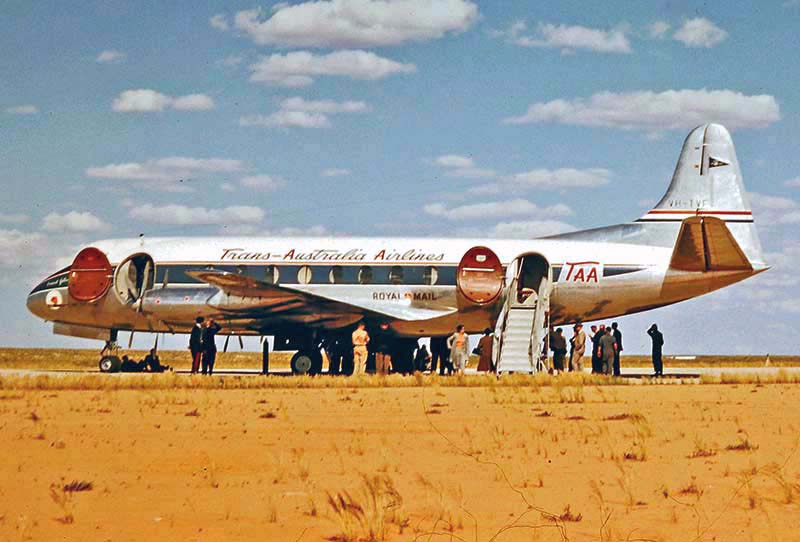
|
|
|
TAA Viscount VH-TVF on a Forrest diversion in 1955. On this occasion several tyres blew out during landing, passengers
patiently
wait while the tyres are replaced. Note the slipper auxiliary fuel tank
on the
wing.
Photo by Colin Hayes
|
|
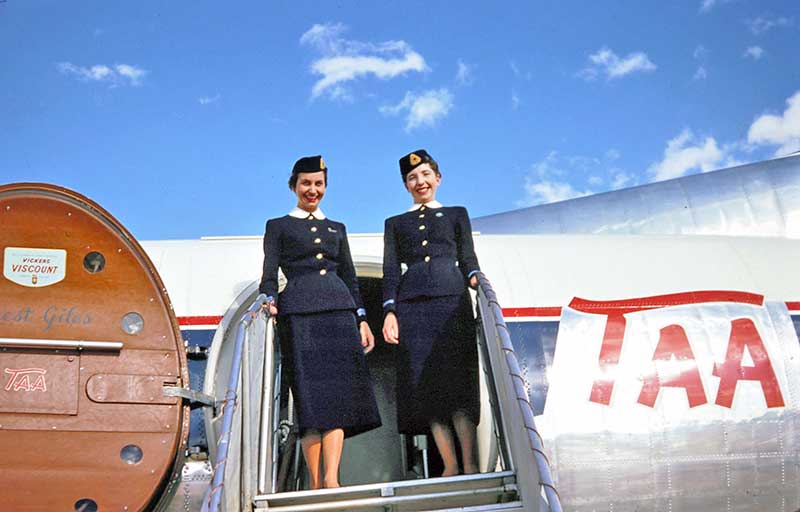
|
|
TAA Viscount air hostesses enjoying their Forrest experience in 1955.
Photo by Colin Hayes
|
|
Forrest 1950s
|
|
The following pictures taken by DCA radio technician Colin Hayes give
an idea of of life for DCA personnel based at Forrest Airport during
the 1950-1960s. Significant improvements were made to the runways
and taxiways for larger airliner diversions, new radio navigation aids
installed, while the Aeradio Station radio and communications systems
were routinely upgraded. The hub for all staff was the Aeradio building with its accommodation and meals areas.
|
|
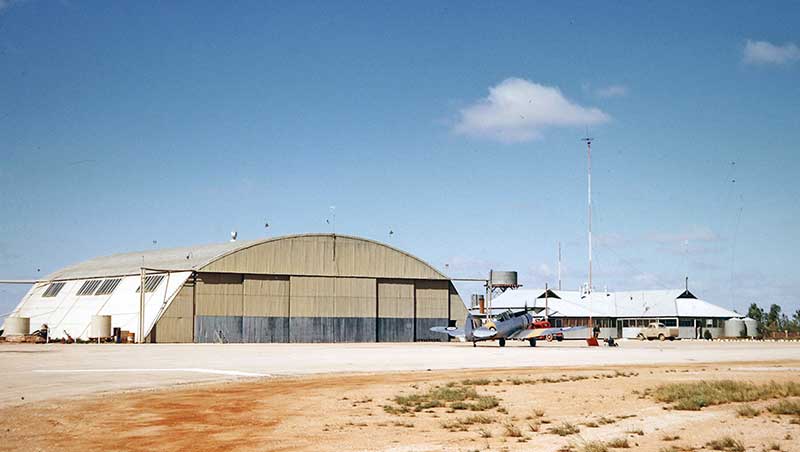
|
|
Forrest Airport 1955 with a RAAF CAC Wirraway making a refelling stop
|
|

|
|
The Forrest railway siding and fettlers camp seen from a DCA radio mast at the airport in 1965
|
|

|
|
A young Col Hayes in 1955 with field test set at the Forrest VAR (Visual Aural Range) radio navigation aid site.
|
|

|
|
Commonwealth Railways train pulls into the Forrest siding in 1955
|
|
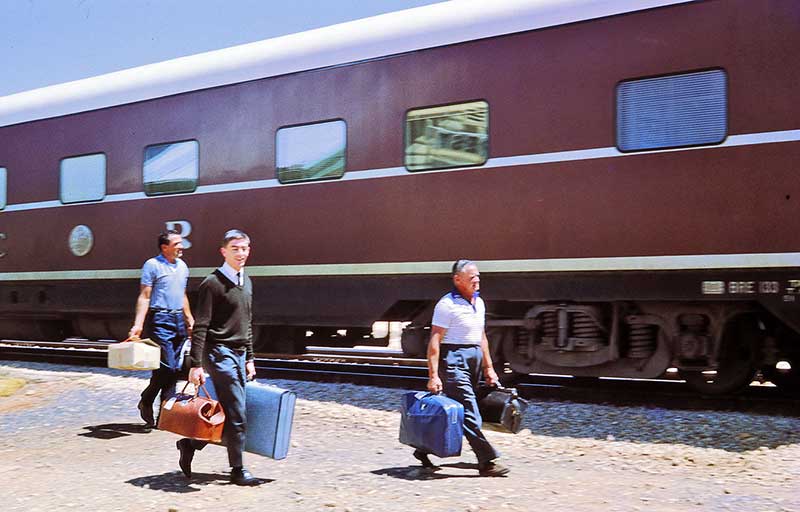
|
|
Replacement DCA technical staff arrive at Forrest from Perth in 1955 by Commonwealth Railways
|
|

|
|
Going home. A DCA technician and family wait for the train to Perth at the end of their Forrest attachment in 1955
|
|
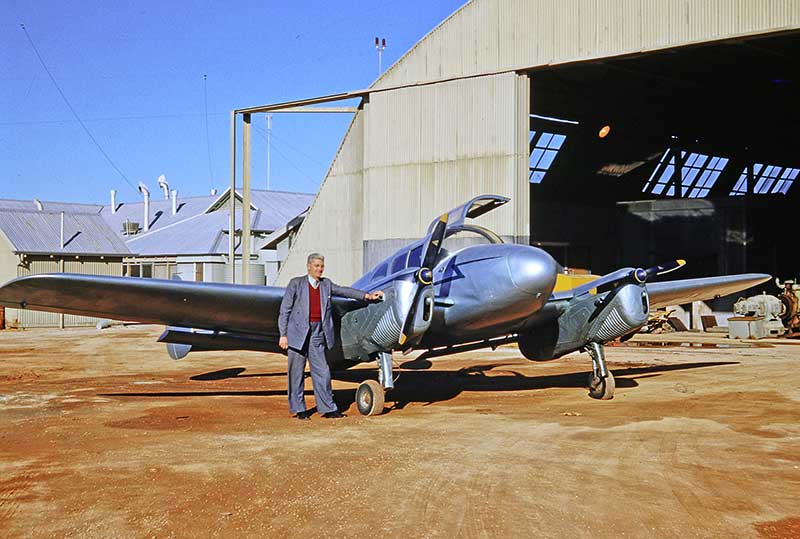
|
|
Miles Gemini VH-AKV flown by Perth businessman Mr.O.Odegaard during a stop at Forrest in 1955
|
|

|
|
TAA DC-3 VH-TAF brought parts for a TAA Viscount grounded at Forrest during 1955
|
|

|
|
RAAF Canberras make a refuelling stop at Forrest in 1955
|
|

|
|
Vampires of 25 Squadron, Pearce WA being refuelled at Forrest in 1955 from a stockpile of fuel drums
|
|
And more recent times
|
|
|
|
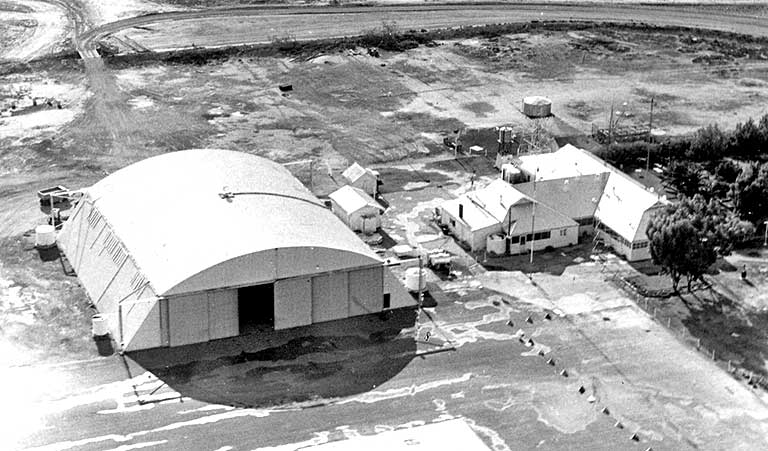
|
|
Aerial view in 1972 shows the hostel building still in use by the various DCA maintenance sections, plus staff living quarters.
The Aeradio/Flight
Service Unit had been closed some years
earlier.
Photo by
Geoff Goodall
|
|
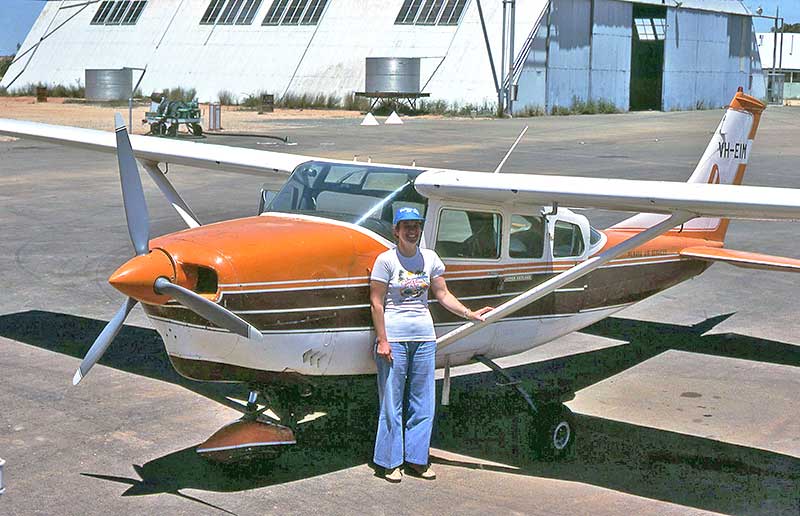
|
|
A typical light aircraft refuelling stop at Forrest. My wife Jane
ferrying a Cessna 206 from Perth to Melbourne in 1978
|
|
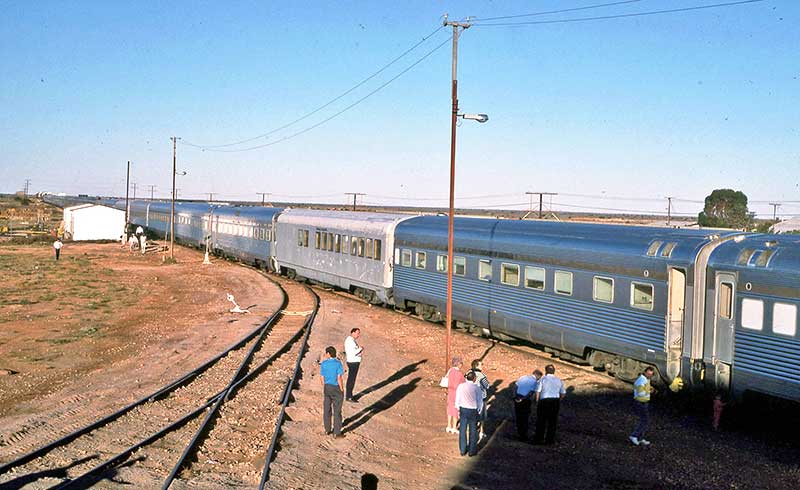
|
|
The transcontinental railway line is today the popular luxurious "Indian Pacific" commercially-operated service.
I took this photo in 1989 at Rawlinna, 100 miles west of Forrest, while the train was still run by Commonwealth Railways in
a far more utilitarian fashion. A brief PA announcement "There will be a short delay at Rawlinna" preceeded a 30 hour wait
with not another announcement. We later learnt the cause was a freight train derailment at Forrest.
|
|

|
|
Forrest
Airport in 1989 through the tinted window of the Indian Pacific
Perth-Adelaide train.
Photo by Geoff
Goodall
|
|
|
|
Forrest Airport Today
|
|
Forrest still provides an important service
for a variety of aircraft and helicopters crossing
the country. Resident caretakers look after the essential aircraft
refuelling facilities and offer a comfortable rest stop for pilots and
passengers. The hostel building has gone, but overnight accommodation
is available in renovated fettler cottages at the nearby railway
siding, with hot meals delivered to the door. Visiting aircraft can
usually stay inside the hangar, out of the desert heat and occasional
stormy weather. There is even a small historical display covering the
airfield's past years.
Professional ferry pilot
David Prossor, who has made a number of Forrest stopovers, gives the
following insight:
|
|
Forrest Airport. An oasis in the middle of nowhere.
The howl of the dingos and the Indian–Pacific train roaring past after midnight will stay with me forever.
And the sky is so clear. No smog. Lots of stars!
The
resident husband and wife team look after everything on the airport.
They live there for up to a year, then are replaced by another couple.
The airport is operated by a WA firm. It even has a Post Office.
It is a critical fuelling stop for East-West-East bound light
aircraft and that includes the Navy, Army and Air Force. Av Gas
and Jet A-1 is available. Even then, some aircraft still need to carry
jugs of fuel to land and top up somewhere between Forrest and
Kalgoorlie. I did!
Memories of Forrest. The engine
issue I had in a Piper Aztec that grounded me there. The WA owner arranged
for an engineer to be flown out. An expensive fix. Having dinner
on the patio of the resident couple's house, chatting with the guys who
came to fix my Aztec. We had been to so many of the same places
overseas. Small world. Once I was given a tour of the airport with the
hubby of the resident team. We drove all around the fence line and saw
this and that. The rubbish dump is called "Bunnings" because when they
need a few nuts and bolts for whatever, they "go to Bunnings"! I
had a good check of the tip. There are no bits of wartime B-17s or
P-40s there! Sorry to disappoint you.
|
|
|
|
|
|
Back to the Australian
Aviation Menu

|
|
|
|
|
|
|
|
|
|




























